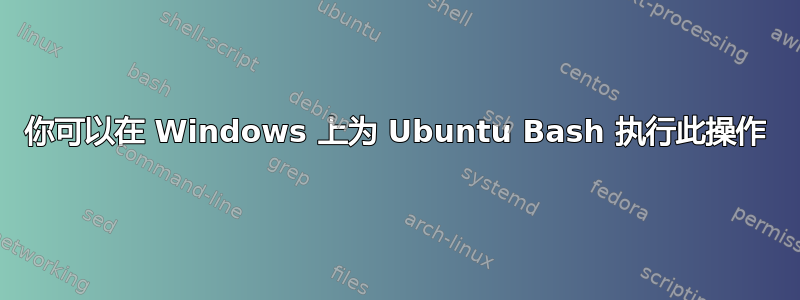
我正在设置的计算机有三个分区,一个用于 Windows 10,一个用于 Linux,一个用于它们之间共享的文件和程序。有没有办法在第三个分区上安装程序(如 Python、PyCharm、MATLAB 等)以在两个操作系统上运行,还是我必须在每个操作系统上安装各自版本的 Python、C++ 等?第三个分区是否仅限于共享文件,还是可以用于共享 IDE、应用程序、编译器和解释器?
答案1
您将无法在第三个分区中安装程序,以便它们可以在两个操作系统上运行。您需要根据您的操作系统进行不同的下载,这是有原因的,每个操作系统对软件的要求都不同。
如果需要,您应该能够将其设置为共享许可证,并且您可能能够将其设置为自动共享生成的文件,甚至可能是 IDE 设置,但程序本身必须安装在每个系统中。
一种解决方法可能是设置从一个操作系统到另一个操作系统的 x11 转发,但这需要您同时运行两个操作系统,这会非常不稳定。
附注:如果您有 2 个分区,分别是 Ubuntu 而不是 Ubuntu 和 Windows,这可能是可行的。
答案2
对于几乎所有程序来说,不是。这是因为 Windows 和 Linux 具有不同的 API(应用程序编程接口)调用和系统调用。API 是函数,定义程序如何相互通信。通常,它们包含在库中或可能是操作系统的一部分。系统调用定义程序如何从内核请求硬件支持/活动。可以将一个操作系统的 API 调用和系统调用转换为另一个操作系统,但这需要付出巨大的努力。WINE 实际上是将 Windows API 转换为 POSIX(例如 Linux)API 的一个典型示例。这在 Windows 和 Linux 之间创建了一个兼容层,允许一些 Windows 软件在 Linux 上运行。此外,Windows 和 Linux 具有不同的二进制可执行格式。Windows 具有可移植可执行 (PE) 格式,而 Linux 具有 ELF(可执行可链接格式)。
尽管如此,我认为如果不付出巨大努力,你无法实现你想要实现的目标。也许(很有可能)你可以在共享分区上安装 WINE 并对其进行配置,以便它可以同时容纳 Windows 和 Linux 的程序。但这是一个荒谬的理论。Jeff 这位用户所说的有关许可证和其他文件的内容更有可能实现,而且更容易实现。
答案3
你可以在 Windows 上为 Ubuntu Bash 执行此操作
这是我的分区设置:
$ lsblk -o NAME,FSTYPE,LABEL,MOUNTPOINT,SIZE,MODEL
NAME FSTYPE LABEL MOUNTPOINT SIZE MODEL
sda 931.5G HGST HTS721010A9
├─sda4 ntfs WINRETOOLS 450M
├─sda2 128M
├─sda5 ntfs Image 11.4G
├─sda3 ntfs HGST_Win10 /mnt/d 919G
└─sda1 vfat ESP 500M
nvme0n1 477G Samsung SSD 960 PRO 512GB
├─nvme0n1p5 ext4 NVMe_Ubuntu_16.0 / 44.6G
├─nvme0n1p3 16M
├─nvme0n1p1 ntfs 450M
├─nvme0n1p6 swap Linux Swap [SWAP] 7.9G
├─nvme0n1p4 ntfs NVMe_Win10 /mnt/c 414.9G
├─nvme0n1p2 vfat /boot/efi 99M
└─nvme0n1p7 ntfs Shared_WSL+Linux /mnt/e 9G
nvme0n1p7在 Windows 和 Ubuntu 之间共享
我设置了一个 9 GB 的分区,WSL(适用于 Linux 的 Windows 子系统)和 Ubuntu 都可以在其路径中拥有并运行程序。这是它的树:
$ sudo tree /mnt/e -d
/mnt/e
├── bin
├── boot
│ └── grub
│ ├── fonts
│ ├── i386-pc
│ └── locale
├── Desktop
├── Documents
├── Downloads
│ └── WinScreeny-master
├── etc
│ ├── apt
│ │ ├── sources.list.d
│ │ └── trusted.gpg.d
│ ├── cron.d
│ │ └── test-directory
│ ├── cron.daily
│ ├── cron.hourly
│ ├── cron.monthly
│ ├── cron.weekly
│ ├── default
│ ├── ssmtp
│ └── systemd
│ ├── network
│ ├── system
│ │ ├── bluetooth.target.wants
│ │ ├── default.target.wants
│ │ ├── display-manager.service.wants
│ │ ├── final.target.wants
│ │ ├── getty.target.wants
│ │ ├── graphical.target.wants
│ │ ├── hibernate.target.wants
│ │ ├── hybrid-sleep.target.wants
│ │ ├── multi-user.target.wants
│ │ ├── network-online.target.wants
│ │ ├── paths.target.wants
│ │ ├── printer.target.wants
│ │ ├── sleep.target.wants
│ │ ├── sockets.target.wants
│ │ ├── suspend.target.wants
│ │ ├── sysinit.target.wants
│ │ └── timers.target.wants
│ └── user
├── lib
│ └── systemd
│ └── system-sleep
├── $RECYCLE.BIN
│ └── S-1-5-21-1568003092-1971238075-3041751339-1001
├── System Volume Information
├── Temporary Work
├── usr
│ ├── local
│ │ └── bin
│ │ ├── bell
│ │ │ └── sounds
│ │ ├── startup-scripts
│ │ └── zap
│ │ └── Assembly-Intro-hello
│ │ ├── BeOS
│ │ ├── FreeBSD
│ │ └── Linux
│ └── share
│ └── plymouth
│ └── themes
│ ├── details
│ ├── earth-sunrise
│ ├── text
│ ├── tribar
│ ├── ubuntu-logo
│ └── ubuntu-text
└── wsl-linux-tmp
71 directories
制作混合程序
我使用了我的一个 bash 程序:Ubuntu 中在一定时间后锁定屏幕的应用程序并对其进行了修改,使其能够识别在 Windows 10 下运行时的情况,并发出powershell命令而不是 Ubuntu 命令来发出消息气泡和系统声音。
例如,这里有一个代码片段,用于检查环境是否是 Windows 并使用与 Ubuntu 不同的命令:
if [[ $WSL_running == true ]]; then
powershell.exe -c '(New-Object Media.SoundPlayer "C:\Windows\Media\notify.wav").PlaySync();'
else
ogg123 '/usr/share/sounds/ubuntu/stereo/phone-outgoing-calling.ogg' ;
fi
以下是应用程序成为 Windows / Ubuntu 混合版本后的完整 bash 代码:
$ cat /mnt/e/bin/lock-screen-timer
#!/bin/bash
# NAME: lock-screen-timer
# PATH: $HOME/bin
# DESC: Lock screen in x minutes
# CALL: Place on Desktop or call from Terminal with "lock-screen-timer 99"
# DATE: Created Nov 19, 2016. Last revision Nov 12, 2017.
# UPDT: Updated to support WSL (Windows Subsystem for Linux)
# NOTE: Time defaults to 30 minutes.
# If previous version is sleeping it is killed.
# Zenity is used to pop up entry box to get number of minutes.
# If zenity is closed with X or Cancel, no screen lock timer is launched.
# Pending lock warning displayed on-screen at set intervals.
# Write time remaining to ~/.lock-screen-timer-remaining
MINUTES="$1" # Optional parameter 1 when invoked from terminal.
# if no parameters set default MINUTES to 30
if [ $# == 0 ]; then
MINUTES=30
fi
DEFAULT="$MINUTES" # When looping, minutes count down to zero. Save deafult for subsequent timers.
# Check if lock screen timer already running
pID=$(pgrep -f "${0##*/}") # All PIDs matching lock-screen-timer name
PREVIOUS=$(echo "$pID" | grep -v ^"$$") # Strip out this running copy ($$$)
if [ "$PREVIOUS" != "" ]; then
kill "$PREVIOUS"
rm ~/.lock-screen-timer-remaining
zenity --info --title="Lock screen timer already running" --text="Previous lock screen timer has been terminated."
fi
# Running under WSL (Windows Subsystem for Linux)?
if cat /proc/version | grep Microsoft; then
WSL_running=true
else
WSL_running=false
fi
while true ; do # loop until cancel
# Get number of minutes until lock from user
MINUTES=$(zenity --entry --title="Lock screen timer" --text="Set number of minutes until lock" --entry-text="$DEFAULT")
RESULT=$? # Zenity return code
if [ $RESULT != 0 ]; then
break ; # break out of timer lock screen loop and end this script.
fi
DEFAULT="$MINUTES" # Save deafult for subsequent timers.
if [[ $MINUTES == 0 ]] || [[ $MINUTES == "" ]]; then
break ; # zero minutes considered cancel.
fi
# Loop for X minutes, testing each minute for alert message.
(( ++MINUTES ))
while (( --MINUTES > 0 )); do
case $MINUTES in 1|2|3|5|10|15|30|45|60|120|480|960|1920)
notify-send --urgency=critical --icon=/usr/share/icons/gnome/256x256/status/appointment-soon.png "Locking screen in ""$MINUTES"" minute(s)." ;
if [[ $WSL_running == true ]]; then
powershell.exe -c '(New-Object Media.SoundPlayer "C:\Windows\Media\notify.wav").PlaySync();'
else
ogg123 '/usr/share/sounds/ubuntu/stereo/phone-outgoing-calling.ogg' ;
fi
;;
esac;
# Record number of minutes remaining to file other processes can read.
echo "$MINUTES Minutes" > ~/.lock-screen-timer-remaining
sleep 60
done
rm ~/.lock-screen-timer-remaining # Remove work file others can see our progress with
if [[ $WSL_running == true ]]; then
# Call lock screen for Windows 10
rundll32.exe user32.dll,LockWorkStation
else
# Call screen saver lock for Ubuntu versions > 14.04.
dbus-send --type=method_call --dest=org.gnome.ScreenSaver /org/gnome/ScreenSaver org.gnome.ScreenSaver.Lock
fi
# Reset sound to Laptop or HDMI TV - Uncomment to fix sound device changing
# sleep 5 # HDMI deactivates when screen turned off. Give 5 seconds for TV to resync screen.
# hotplugtv
done # End of while loop getting minutes to next lock screen
exit 0 # Closed dialog box or "Cancel" selected.


